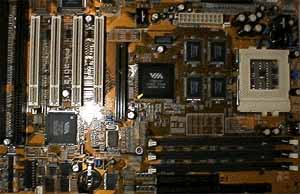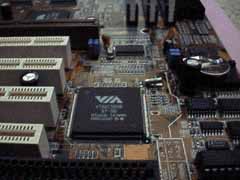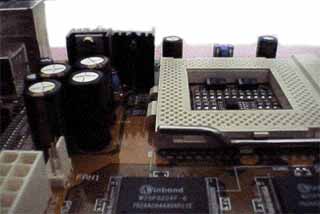
Original Link: https://www.anandtech.com/show/63
FIC PA-2012 VP3 AGP Socket-7 Board
by Anand Lal Shimpi on January 19, 1998 7:41 PM EST- Posted in
- Motherboards
Intel managed to convince the market that the future of the PC world lay with the newly released LX AGPSet mainly because no other chipset manufacturer could boast the ability to combine the performance of a dedicated AGP bus along with SDRAM support, and support for the Ultra ATA specification...until now. VIA Technologies, the pioneers of chipsets that provide the greatest threat to Intel's throne, announced the VP3 AGP Chipset as a competitor to Intel's LX AGPSet months before its release, however the catch was that the VP3 AGP Chipset would be an AGP capable chipset for Socket-7 CPUs! Intel virtually abandoned the Socket-7 market when they migrated to the proprietary Slot-1 design of the Pentium II, however companies like AMD and VIA in correspondence with each other managed to breathe more life into the seemingly dead standard.
FIC has been known for their excellent motherboard designs based on VIA chipsets, and with the announcement of the VP3 chipset came an announcement of equal caliber from FIC, the announcement of a motherboard based on this new chipset, the PA-2012. How well has FIC harnessed the power of VIA's VP3 chipset? Very well indeed...
| Socket Style: | Socket-7 |
| Chipset: | VIA VP3 |
| Cache: | 1024KB |
| Form Factor: | ATX |
| BUS Speeds: | 55 / 60 / 66 / 75 MHz |
| Clock Multipliers: | 1.5x / 2.0x / 2.5x / 3.0x / 3.5x / 4.0x / 4.5x / 5.0x / 5.5x |
| Voltages Supported: | 2.1v / 2.8v / 2.9v / 3.2v / 3.3v |
| RAM Slots: | 3 168pin DIMM Slots (EDO/SDRAM) |
| AGP/PCI/ISA Slots: | 1 AGP Slot 4 PCI Slots 2 ISA Slots (1 Shared / 2 Full Length) |
| BIOS: | AWARD PnP BIOS |
| PCI EIDE Controller: | Super I/O 2 EIDE Channels 1 FDD Channel 2 Serial /1 EPP |
Imagine for a minute in your mind, the idea of a perfect Socket-7 motherboard. What form factor would it be based upon? How many SIMM/DIMM slots would it have? How much RAM would it be able to cache? Next, take a look at the FIC PA-2012...notice any similarities?
 |
FIC's goal with their earlier motherboards was simply releasing a high quality motherboard that could knock the socks off of anyone that used it. However with the PA-2012 the goal was perfection, plain and simple. Starting with the excellent layout of the 2012 courtesy of the ATX form factor it is based upon, the PA-2012 provides 4 PCI & 2 ISA slots and of course, that one precious AGP slot. Unlike some other newer ATX motherboards, the PA-2012 fully meets the ATX specification by placing the Socket-7 IC in the path of the air flow from the ATX Power Supply in your case and by placing the HDD/FDD connectors at the corner of the motherboard convenient to the drive bays in most ATX cases. |
| Don't plan to recycle your old SIMMs with the PA-2012, FIC took the route most manufacturers have been taking with the PA-2012 by including a total of 3 DIMM slots capable of accepting EDO or SDRAM DIMMs in 8MB, 16MB, 32MB, 64MB, 128MB, or 256MB modules for a total of 768MB of RAM. |  |
| Now that 768MB memory limit wouldn't be much of anything if you could only cache 64MB of it, however with the 1MB of onboard L2 cache on the PA-2012 along with the sheer power of the VIA VP3 chipset you can realistically use all 768MB of RAM without the worry of a uncached performance hit. This is a result of the massive 1GB Cacheable Memory Area of the VIA VP3 chipset, a feature of the VP3 chipset that can even outshine the more expensive "high-end" Pentium II systems which are limited to a cacheable memory area of only 512MB. Along with the immense cacheable memory area the VP3 chipset provides, it also gives the PA-2012 the power to support Ultra DMA/33 hard drives as well as lightning fast SDRAM, not to mention the support for future DDR-SDRAM. | |
 |
As mentioned earlier, one of the key features of FIC's PA-2012 is the onboard Accelerated Graphics Port (AGP) whose dedicated bus allows for incredible 3D graphics performance to be brought down to desktop PC levels. Taking advantage of the AGP port on the PA-2012 in addition to all VP3 based motherboards, is a little more tricky than with LX motherboards. |
| Not only do you need to use your video card manufacturer's AGP drivers, but you also need to have VIA's own VxD installed in order to take full advantage of the AGP specification. Luckily, FIC included an extremely useful CD with the PA-2012 containing not only the hard to find VIA Bus Mastering Drivers but VIA's AGP VxD files as well as a few other handy utilities. | |
While the PA-2012 is an excellent motherboard, its quality extends much further than the ease of its setup and initial installation. Boasting PC '97 compliance, the PA-2012's bundled CDROM includes a Desktop Management Interface utility identical to those found in many of ASUS' and AOpen's offerings. Along with that the 2012 sports its own set of patent-pending Intelligent System Management & Protection features (ISMPTM) which include a CPU Thermal Monitoring Alert a feature common to many Shuttle Motherboards, a Chassis Intrusion Alarm which alerts a system administrator if the case chassis is opened, as well as System Over-Voltage Protection & Report, a feature that automatically shuts the system down if the I/O or CPU Core voltage increases by a factor greater than 5%.
The written documentation of the PA-2012 is characteristic of most newer 1stMainboard (FIC manufactures motherboards under the 1stMainboard title) manuals, thorough, detailed, and easy to read. The PA-2012's user manual documents a simple 6-step installation procedure for the motherboard and provides detailed pictures on how to install and configure every aspect of your new purchase. The manual even goes as far as to differentiate between the physical differences of a Pentium MMX and a Pentium Classic (as well as a 6x86 & a 6x86MX) in order to eliminate any possible confusion for first time system builders.
 |
Supporting clock multipliers from a meager 1.5x to 5.5x (for future CPUs) and CPU core voltages from 2.1v for the AMD K6-266/300 up to 3.3v for the true overclocker the PA-2012 keeps future expandability options open to virtually any user. Support for the 75MHz bus speed on the PA-2012 isn't documented in the manual but is documented on the motherboard itself although officially the VP3 chipset doesn't support bus speeds higher than 66MHz. |
| Unfortunately FIC left out the 83.3MHz bus speed setting, and the two-jumper design of the bus speed settings on the 2012 eliminate the possibility of there being any hidden settings corresponding to the 83.3MHz bus speed. Stability at all overclocked and normal clock speeds with the PA-2012 is spoken for quite well by the 20 mid-size to large electrolytic capacitors scattered around the motherboard. High concentrations of capacitors exist around the Socket-7 IC as well as the switching voltage regulators which are taken care of by the large heatsinks designed to dissipate the large quantities of heat they produce during normal and overclocked operation. | |
Performance-wise the PA-2012 can be beat by the best of the best, however considering its tremendous feature set as well as its above average performance in ALL categories the PA-2012 disserves the title of Best Overall Socket-7 Motherboard. At all possible clock speeds, regardless of which CPU is used the PA-2012 will give you the most bang for your buck, it stays competitive in all situations which is a quality most manufacturers cannot flaunt.
The PA-2012's shortcomings?
Only supports AGP 1X Mode
No 83.3MHz bus speed support
Only 2 ISA Slots
Clock Multiplier/Bus Speed Jumpers are located in difficult to access places on the motherboard itself
There isn't much to complain about with the PA-2012, it works flawlessly with most brands of SDRAM in pairs and in triples, so next month when this motherboard is released try to get your hands on one.
IRQ Usage
Allows user to individually set IRQs for each Legacy ISA card
Allows user to configure IRQ Assignment Sequence
Allows user to Assign IRQ for VGA/USB
Auto-detects PnP Cards after HDD Detection
| FIC PA-2012 Chipset Features Setup | |||
| Item | 66MHz Setting | 75MHz Setting | Safe Setting |
| Video BIOS Cacheable: | Enabled | Enabled | Disabled |
| System BIOS Cacheable: | Enabled | Enabled | Disabled |
| Memory Hole At 15M - 16M: | Disabled | Disabled | Disabled |
| Sustained 3T Write: | Enabled | Enabled | Disabled |
| Cache Pipeline: | Enabled | Enabled | Enabled |
| DRAM Read Pipeline: | Enabled | Enabled | Enabled |
| Read Around write: | Enabled | Enabled | Disabled |
| Memory ECC Check: | Disabled | Disabled | Disabled |
| Bank 0/1 DRAM Timing: | Turbo | Turbo | Turbo |
| Bank 2/3 DRAM Timing: | Turbo | Turbo | Turbo |
| Bank 4/5 DRAM Timing: | Turbo | Turbo | Turbo |
| SDRAM Single/Burst Write: | Burst | Burst | Single |
| SDRAM Cycle Length: | 2 | 3 | 3 |
| SDRAM Bank Interleave: | 4 Bank | 4 Bank | Disabled |
| Aperture Size: | 32M | 32M | 32M |
This little addition to my review layout was put in here just so you all can have an idea of what brand of SDRAM I recommend and have tested with the board, just to avoid problems in the future if you decide to purchase the board.
Recommended SDRAM: Advanced Megatrends SDRAM
SDRAM Tested: 2 x 32MB Advanced Megatrends SDRAM DIMMs; 2 x 32MB Corsair SDRAM DIMMs
Manufacturer: Advanced Megatrends
Purchase Web-Site: http://www.megacom.com
Manufacturer: Corsair Microsystems
Purchase Web-Site: http://www.nf-ny.com
The Test
In recent times, choosing a motherboard cannot be completely determined by a Winstone score. Now, many boards come within one Winstone point of each other and therefore the need to benchmark boards against each other falls. Therefore you shouldn't base your decision entirely on the benchmarks you see here, but also on the technical features and advantages of this particular board, seeing as that will probably make the greatest difference in your overall experience.
Test Configuration
| Processor(s): | AMD K6/233 ANR & Intel Pentium MMX 233 & Cyrix 6x86MX-PR2/200 |
| RAM: | 2 - 32MB Advanced
Megatrends SDRAM DIMMs 2 - 32MB Corsair SDRAM DIMMs |
| Hard Drive(s): | Western Digital Caviar AC21600H |
| Video Card: | ATI Xpert@Work
(4MB SGRAM) Matrox Millennium II (4MB WRAM) |
| Busmaster EIDE Drivers: | VIA v2.13 |
| Video Card Drivers: | MGA Millennium 4.03.00.3410 |
| OS: | Windows 95 Service Release 2 |
| Windows 95 Performance of the PA-2012 (PCI Video) | ||||
| CPU | Business Winstone 97 | Business Winstone 98 | Bus. Gfx. Winmark 97 | Bus. Gfx. Winmark 98 |
| AMD K6-200 | 53.2 | Not Run | 103 | Not Run |
| AMD K6-225 | 56.9 | Not Run | 116 | Not Run |
| AMD K6-233 | 56.0 | 17.5 | 111 | 107 |
| Cyrix 6x86MX-PR2/200 (150/75) | 55.2 | Not Run | 104 | Not Run |
| Cyrix 6x86MX-PR2/200 (166/66) | 56.1 | Not Run | 112 | Not Run |
| Intel Pentium MMX - 200 | 51.4 | Not Run | 104 | Not Run |
| Intel Pentium MMX - 225 | 53.5 | Not Run | 109 | Not Run |
| Intel Pentium MMX - 233 | 52.1 | 16.8 | 107 | 110 |
| Intel Pentium MMX - 262.5 | 55.6 | Not Run | 118 | Not Run |
The PCI Video Performance of the PA-2012 is outstanding, however when using an AGP video card the performance increase isn't as great when compared to identical configurations with LX motherboards. In any case, the PA-2012's performance is top-notch although it could be much better.
| Windows 95 Performance of the PA-2012 (AGP Video) | ||||
| CPU | Business Winstone 97 | Business Winstone 98 | Bus. Gfx. Winmark 97 | Bus. Gfx. Winmark 98 |
| AMD K6-200 | 53.5 | Not Run | 103 | Not Run |
| AMD K6-225 | 57.2 | Not Run | 116 | Not Run |
| AMD K6-233 | 56.4 | 17.7 | 114 | 109 |
| Cyrix 6x86MX-PR2/200 (150/75) | 55.4 | Not Run | 108 | Not Run |
| Cyrix 6x86MX-PR2/200 (166/66) | 56.3 | Not Run | 116 | Not Run |
| Intel Pentium MMX - 200 | 51.5 | Not Run | 105 | Not Run |
| Intel Pentium MMX - 225 | 53.7 | Not Run | 111 | Not Run |
| Intel Pentium MMX - 233 | 52.3 | 16.9 | 109 | 110 |
| Intel Pentium MMX - 262.5 | 55.8 | Not Run | 119 | Not Run |
| Performance of the PA-2012 | ||||
| CPU | Business Disk Winmark 98 | High End Disk Winmark 98 | VGA Bench | SVGA Bench |
| AMD K6-233 (AGP Video) | 865 | 2200 | 128.2 fps | 32.7 fps |
| Intel Pentium MMX - 233 (AGP Video) | Not Run | Not Run | 116.9 fps | 38.8 fps |
How well has FIC harnessed the power of the VIA VP3 chipset? Very well, in one month FIC will release the PA-2012 and as long as its shortcomings don't bother you incredibly it will make the perfect Socket-7 Motherboard...at least until ABIT's IT5A makes its way into the market...







